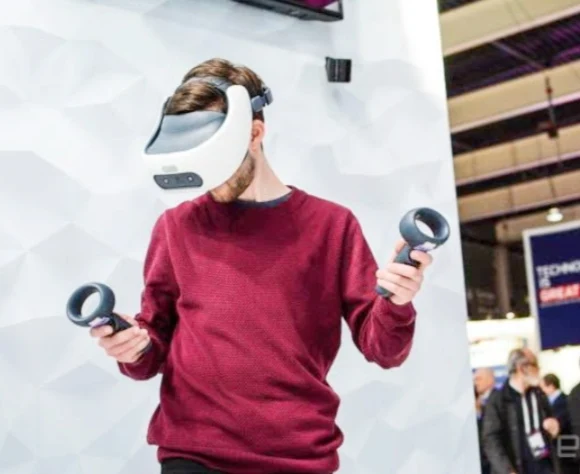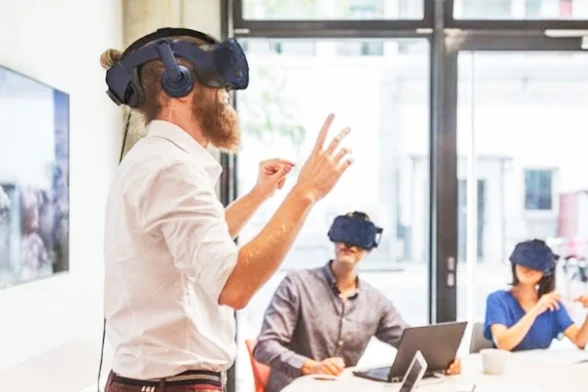Unveiling Meta's Project Cambria: A Headset Poised for the Future of VR and MR
Meta, formerly known as Facebook, has been making waves in the VR (virtual reality) space. Their latest project, codenamed Cambria, has generated significant excitement due to its focus on mixed reality (MR) experiences. While the official name and release date are yet to be revealed, here's a glimpse into what Project Cambria might offer:
Meta's Project Cambria: A Timeline (as of March 2024)
Here's a timeline of Meta's Project Cambria in table format:
| Date (estimated) | Event |
|---|---|
| Early 2021 - Mid-2021 | Rumors and speculation about "Cambria" begin. |
| September 2021 | Oculus Quest 3 announced at Facebook Connect, but no mention of Cambria. |
| November 2021 | Meta CEO Mark Zuckerberg discusses a future VR headset with features like face and eye tracking. |
| January 2022 | Meta leaks reveal details about Cambria, including a potential name change to "Meta Quest Pro". |
| October 2022 | Meta Connect conference reiterates focus on advanced VR but no Cambria announcement. |
| Present Day (March 2024) | Leaks continue, but Meta has yet to officially unveil the device. |
Beyond Virtual Reality: Stepping into Mixed Reality
Unlike the Meta Quest 2, which is primarily a VR headset, Cambria is designed for both VR and MR. This is achieved through high-resolution, full-color passthrough cameras. These cameras allow users to see the real world seamlessly blended with the virtual world, opening doors for innovative applications.
Imagine working in a virtual workspace with multiple screens while still seeing your physical desk clearly enough to grab a pen. Cambria's MR capabilities could revolutionize fields like design, engineering, and even fitness, where virtual objects can interact with the real environment.
Technical Specifications (Speculative)
While official specs haven't been released, rumors suggest Cambria will boast significant upgrades over the Quest 2. Here's a possible breakdown:
| Feature | Speculation |
|---|---|
| Display | High-resolution displays (potentially exceeding Quest 2) |
| Refresh Rate | 90 Hz or higher |
| Processor | Next-generation Qualcomm Snapdragon XR chip |
| Graphics | Improved graphics capabilities for high-fidelity visuals |
| RAM | Increased RAM for smoother performance |
| Storage | Ample storage space for VR/MR applications |
| Controllers | New controllers with enhanced tracking capabilities (potential) |
Looking Ahead: When and Who Should Get Excited?
With its focus on MR, Cambria appears to be a step towards a more integrated future where the virtual and real worlds coexist. While a release date hasn't been announced, many expect it to arrive in 2024.
This headset is likely targeted towards:
- Professionals: Architects, engineers, and designers seeking a powerful tool for creating and interacting with 3D models in a mixed reality environment.
- VR Enthusiasts: Users seeking a cutting-edge VR experience with high-fidelity visuals and the potential for groundbreaking MR applications.
- Businesses: Companies looking to explore VR/MR for training, collaboration, and product development.
The Future of VR/MR Awaits
Project Cambria represents Meta's push towards a future where VR and MR seamlessly blend. Whether it's working in a virtual office or enhancing your workout routine with virtual trainers, Cambria has the potential to redefine how we interact with technology. As more information becomes available, we'll get a clearer picture of this exciting new headset and its impact on the VR/MR landscape.
Unveiling the Tech Behind Meta's Project Cambria: A Leap Towards a Blended Reality
Project Cambria, Meta's upcoming mixed reality (MR) headset, is shrouded in a bit of mystery, but leaks and educated guesses give us a glimpse into the exciting tech that might power this innovative device. Here's a breakdown of some key areas:
Mixed Reality (MR): The Star of the Show
Unlike the Meta Quest 2, Cambria positions itself at the intersection of VR and the real world through MR. This is achieved with high-resolution color passthrough cameras. These cameras capture the physical environment in real-time, allowing users to see it seamlessly blended with the virtual world.
Imagine seamlessly overlaying virtual objects onto your real workspace or having virtual colleagues join you in a meeting room that appears to be your physical office. The possibilities for collaboration, design, and even education are vast.
Processing Power and Graphics for a Richer Experience
Rumors suggest Cambria will pack a significant processing punch compared to the Quest 2. Here's a possible upgrade:
- Processor: A next-generation Qualcomm Snapdragon XR chip specifically designed for high-performance VR and MR applications.
- Graphics: Improved graphics capabilities to render crisp visuals and complex MR environments smoothly.
High-Resolution Displays for Enhanced Immersion
While specifics are unknown, leaks suggest Cambria might boast higher-resolution displays compared to the Quest 2. This would translate to sharper visuals, reducing the screen door effect (visible gaps between pixels) and creating a more immersive experience.
Advanced Tracking for Seamless Interaction
Project Cambria is expected to have improved tracking capabilities. This could involve enhanced camera setups or new controller technologies to allow for more precise and natural interactions within the VR/MR environment.
Imagine manipulating virtual objects with the same ease and dexterity you would use with real-world objects.
Eye Tracking and Facial Recognition: A Look Towards the Future
Some rumors suggest Cambria might incorporate eye tracking and facial recognition technology. While the exact functionalities are unclear, these features could enable more natural user interfaces, allowing you to control aspects of the MR experience with your gaze or facial expressions.
The Future is Blended: A Glimpse into Applications
The capabilities mentioned above position Cambria as a potential game-changer for various applications:
- Professional Use: Architects and engineers can design and interact with 3D models in a mixed reality environment. Surgeons could practice procedures with virtual overlays.
- Remote Collaboration: Imagine having colleagues virtually present in a meeting room that appears to be your physical office.
- Enhanced Training: Workers can be trained in a safe, simulated environment with virtual tools and equipment.
Unveiling the Full Picture: Still a Work in Progress
It's important to remember that Project Cambria is still under development. While leaks and speculation provide insights, the final functionalities and technical specifications might differ. However, one thing seems certain: Project Cambria has the potential to push the boundaries of VR and usher in a new era of blended reality experiences.
Meta's Project Cambria (Estimated Specs)
Note: Since Project Cambria has not been officially released, this table contains predicted features based on leaks and rumors.
| Technology | Details |
|---|---|
| Processing | Likely high-end mobile processor (unspecified) |
| Memory | Potentially increased RAM compared to Oculus Quest 2 |
| Display | High-resolution displays (possibly per eye) for improved visuals |
| Passthrough Cameras | Color passthrough for mixed reality experiences |
| Tracking | Inside-out tracking with multiple cameras for precise movement detection |
| Sensors | Accelerometer, gyroscope, magnetometer (possibly additional sensors for depth perception) |
| Controllers | New controllers with improved tracking and features (details unknown) |
| Audio | Integrated speakers and microphone |
| Eye Tracking | Rumored eye tracking technology for more natural interactions |
| Face Tracking | Potential face tracking for enhanced avatars and social experiences |


